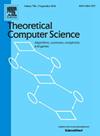The Convex Set Forming Game
IF 1
4区 计算机科学
Q3 COMPUTER SCIENCE, THEORY & METHODS
引用次数: 0
Abstract
In 1984, Frank Harary introduced the first graph convexity game, focused on the geodesic convexity. A set of vertices of a graph is convex if every shortest path between two vertices of S is also included in S. We introduce the Convex Set Forming Game CFG: two players alternately select vertices in such a way that the set of selected vertices is always a convex set. In the normal (resp., misère) variant, the last player to be able to select a vertex wins (resp., loses). We also define a new graph invariant as the largest integer k such that the first player has a strategy ensuring that, at the end of the game, at least k vertices of the graph G have been selected. We first show that the problems of deciding the outcome (does the first player win?) of the game in both variants (normal and misère), as well as the problem of deciding whether , are PSPACE-complete. As a by-product, we prove that the optimization variant of the classical Kayles game is PSPACE-complete. Then, we focus on convexable graphs, i.e., n-node graphs G for which . For this purpose, we say that a set in a graph G admits a Convex Elimination Ordering (CEO) if is convex for every . We show that the class of graphs whose vertex-set admits a CEO coincides with the chordal graphs and that this class strictly contains the convexable graphs. Moreover, every graph which is Ptolemaic (distance-hereditary chordal) or unit interval is convexable. Finally, we give a polynomial-time algorithm for computing a largest set admitting a CEO in outerplanar graphs, which gives upper bounds on in outerplanar graphs G.
凸集形成对策
1984年,Frank Harary推出了第一个图形凸性游戏,专注于测地线凸性。如果图G=(V,E)的两个顶点之间的所有最短路径都包含在S中,则图G=(V,E)的顶点集S≥≥V为凸集。我们引入凸集形成博弈CFG:两个参与者交替选择顶点,使所选顶点集始终为凸集。在正常情况下。, mis)变体,最后一个能够选择顶点的玩家获胜。失去了)。我们还定义了一个新的图不变量gc(G)作为最大的整数k,使得第一个玩家有一个策略,确保在游戏结束时,图G的至少k个顶点被选中。我们首先证明了在两个变量(normal和mis)中决定结果(第一个玩家赢了吗?)的问题,以及决定gc(G)≥k的问题,是pspace完全的。作为一个副产品,我们证明了经典Kayles对策的优化变体是pspace完全的。然后,我们将重点放在可交换图上,即gc(G)=n的n节点图G。为此,我们设图G中的集合S={v1,⋯,v|S|}≥≥1时,如果{v1,⋯,vi}为凸,则集S={v1,⋯,v|S|}存在凸消序(CEO)。证明了顶点集有一个顶点的图与弦图重合,并证明了这类图严格包含可凸图。此外,每一个托勒密图(距离-遗传弦)或单位区间图都是可凸的。最后,给出了计算外平面图上允许一个CEO的最大集合的多项式时间算法,给出了外平面图G上gc(G)的上界。
本文章由计算机程序翻译,如有差异,请以英文原文为准。
求助全文
约1分钟内获得全文
求助全文
来源期刊

Theoretical Computer Science
工程技术-计算机:理论方法
CiteScore
2.60
自引率
18.20%
发文量
471
审稿时长
12.6 months
期刊介绍:
Theoretical Computer Science is mathematical and abstract in spirit, but it derives its motivation from practical and everyday computation. Its aim is to understand the nature of computation and, as a consequence of this understanding, provide more efficient methodologies. All papers introducing or studying mathematical, logic and formal concepts and methods are welcome, provided that their motivation is clearly drawn from the field of computing.
 求助内容:
求助内容: 应助结果提醒方式:
应助结果提醒方式:


